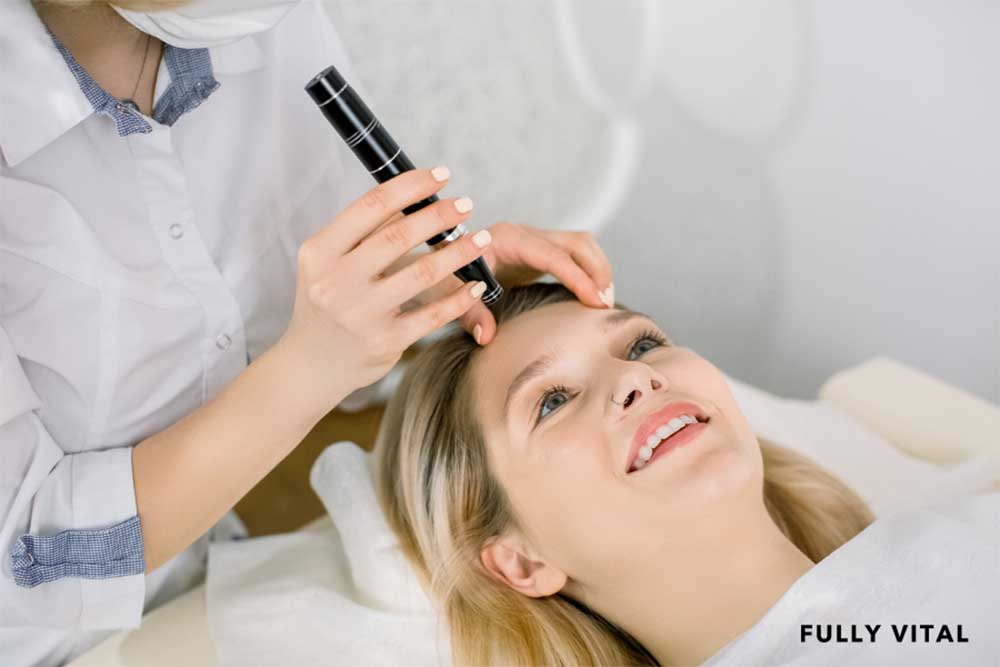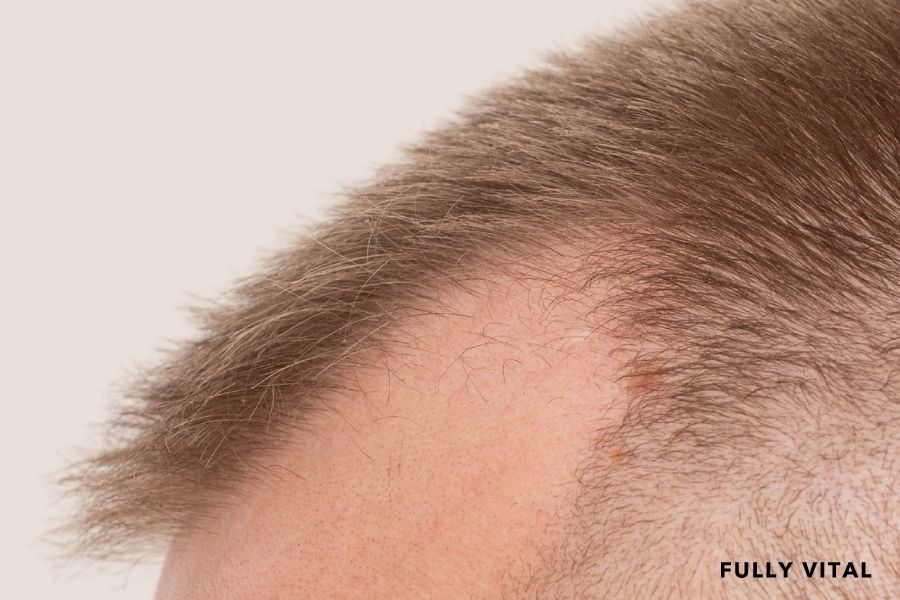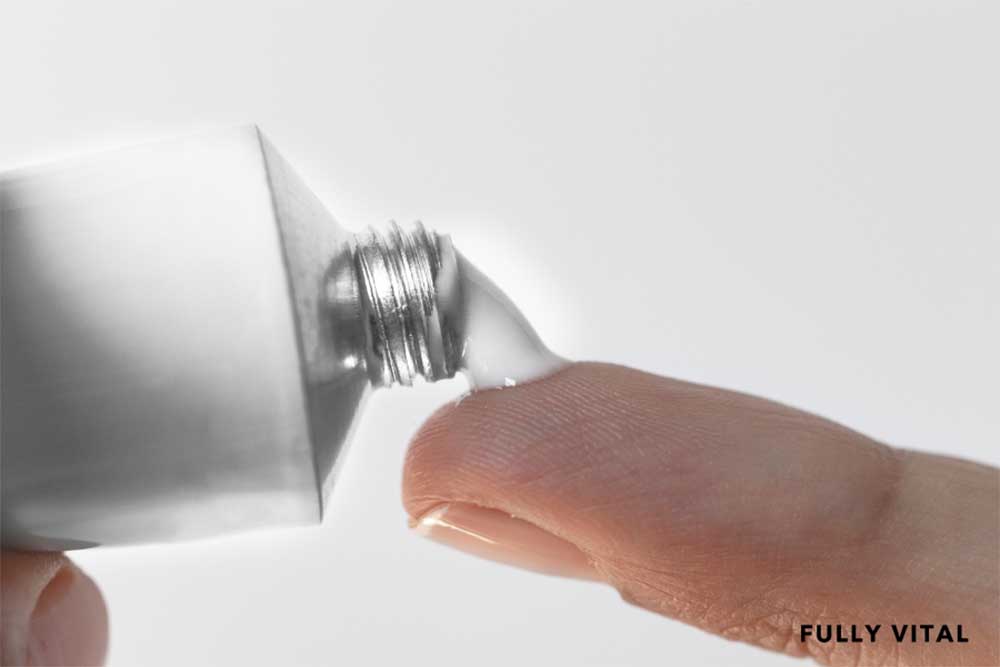
Dermoscopy: A Comprehensive Guide To Understanding And Utilizing It For Hair Growth
Welcome to our in-depth guide on dermoscopy, a pivotal technique that holds the key to unlocking the secrets of hair growth.
If you're a woman seeking to stimulate hair regrowth, regardless of your hair type, you're in the right place.
In this article, we'll walk you through everything you need to know about dermoscopy in a conversational tone.

I LOVE MY HAIR NOW
FullyVital hair serum and hair vitamins made tremendous improvements in my hair. I truly love my hair now.
Dorit S.,
What Is Dermoscopy?
Dermoscopy, also known as dermatoscopy or epiluminescence microscopy, is a non-invasive diagnostic method used by dermatologists to examine the skin and hair follicles at a magnified level.
By utilizing specialized equipment, dermatologists gain insights into the structure and pigmentation of the scalp, aiding in the assessment of hair health and potential regrowth.

What Is The Importance of Dermoscopy?
Understanding why dermoscopy matters is essential for grasping its role in promoting hair growth.
This technique enables professionals to identify various scalp conditions, such as alopecia, and distinguish between different types.
With precise analysis, experts can recommend personalized treatments, making dermoscopy a game-changer in the realm of hair restoration.
How Does Dermoscopy Work?
Dermoscopy involves shining light onto the scalp and using magnification to examine its surface.
This process unveils intricate details that aren't visible to the naked eye.1
By observing hair follicles, pores, and skin texture, dermatologists can assess the health of your scalp, detect potential issues, and devise effective strategies for hair rejuvenation.
What Are The Benefits Of Dermoscopy?
Dermoscopy doesn't just scratch the surface—it delves deep into the world of hair follicles and scalp conditions.
The benefits are manifold:
Early Problem Detection
Dermoscopy allows for the early identification of scalp irregularities, facilitating prompt intervention.
Personalized Solutions
With detailed insights, dermatologists can recommend tailored hair growth solutions based on your unique needs.
Tracking Progress
Throughout your hair growth journey, dermoscopy enables professionals to track improvements and adjust treatments accordingly.
Reduced Guesswork
By pinpointing the root causes of hair issues, dermoscopy eliminates guesswork, leading to more effective outcomes.
What Are The Advantages Of Dermoscopy Over Traditional Methods?
In a face-off between dermoscopy and traditional diagnostic methods, the former takes the lead.
Here's why:
Enhanced Precision
Dermoscopy provides a higher level of precision in identifying scalp and hair follicle characteristics.
Non-Invasiveness
Unlike biopsies or other invasive techniques, dermoscopy is non-invasive and virtually painless.
Real-time Analysis
Dermoscopy offers real-time observations, allowing dermatologists to make instant evaluations and recommendations.

What Are The Alternatives To Dermoscopy?
While dermoscopy is a powerful tool, it's essential to be aware of alternatives.
Some alternatives to consider include:
-
Trichoscopy: Similar to dermoscopy, trichoscopy is a technique specifically designed for hair and scalp examination.2
-
Biopsy: In cases where a more in-depth analysis is necessary, a scalp biopsy might be recommended.
-
Clinical Examination: Traditional clinical examination still holds value, although it may lack the magnified insights dermoscopy provides.
What Is The Procedure When Performing Dermoscopy?
When it comes to performing dermoscopy, the process is straightforward yet revealing.
Here's a breakdown of how it's done:
-
Preparation: Your dermatologist will ensure your scalp is clean and free from any products or substances that might interfere with the examination.
-
Instrument Usage: A dermatoscope, a specialized handheld device with magnification and lighting capabilities, will be used to examine your scalp.
-
Sectioning: Your scalp might be divided into sections for thorough analysis, allowing the dermatologist to focus on different areas.
-
Observation: The dermatologist will carefully examine your scalp using the dermoscope, looking for specific characteristics and patterns that indicate the health and condition of your hair follicles.
-
Documentation: Images or videos might be captured to track changes over time and to aid in the evaluation process during subsequent visits.
What Is The Significance of Dermoscopy Findings in Decoding the Clues of Alopecia?
Alopecia, a condition characterized by hair loss, holds distinct dermoscopy findings that provide valuable insights into its nature:
-
Hair Shaft Variations: Dermoscopy can reveal variations in hair shaft diameter, thickness, and length.
-
Exclamation Mark Hairs: These short hairs with a wider proximal end and tapered distal end are indicative of alopecia areata.
-
Yellow Dots: These pinpoint yellowish dots signify the presence of dystrophic anagen hairs.
-
Cadaver Hairs: Hairs broken at the surface of the scalp, resembling black dots, can suggest androgenetic alopecia.
-
Empty Follicles: Follicles devoid of hair shafts might indicate a more advanced stage of alopecia.
Our Best Sellers
How Reliable Is Dermoscopy?
Dermoscopy stands as a reliable tool in the hands of skilled dermatologists.
Its accuracy lies in:
Enhanced Visualization
Dermoscopy offers an up-close view of the scalp, enabling dermatologists to identify subtle changes that might go unnoticed with the naked eye.
Pattern Recognition
Experts can recognize specific patterns associated with various scalp conditions, aiding in accurate diagnosis.
Progress Tracking
Dermoscopy allows for the tracking of treatment progress and adjustments based on real-time observations.
When Should You Consider Dermoscopy?
Dermoscopy can be a pivotal step in your hair growth journey, and knowing when to consider it is essential:
-
Initial Assessment: If you're experiencing significant hair loss or changes in your hair's appearance, an initial dermoscopy can provide valuable insights.
-
Diagnosis Confirmation: If a preliminary diagnosis has been made, dermoscopy can confirm and refine it, leading to more targeted treatment.
How Do You Go About Deciphering a Normal Hair Dermoscopy?
Understanding what constitutes a normal dermoscopy of hair sets the baseline for comparison when assessing potential issues:
-
Consistent Hair Follicles: A normal dermoscopy reveals consistent spacing and density of hair follicles across the scalp.
-
Uniform Hair Shafts: The hair shafts should appear relatively uniform in thickness and length.
-
No Signs of Inflammation: Absence of redness, scaling, or other signs of inflammation indicates a healthy scalp.
What Is The History Of Dermoscopy?
-
Emergence: Dermoscopy, initially developed for skin cancer diagnosis, found its way into the realm of hair and scalp assessment.3
-
Pioneers: Dermatologists like Johann Saphier and Rudolf Virchow laid the groundwork for magnified skin examination in the 19th century.
-
Evolution: With advancements in technology, dermoscopy's applications expanded to encompass hair and scalp analysis, providing a deeper understanding of hair health.
What Is The Current Landscape of Dermoscopy?
-
Diagnostic Precision: Dermoscopy offers unparalleled accuracy in diagnosing scalp conditions, enabling personalized treatments.
-
Treatment Guidance: Insights gained from dermoscopy aid in tailoring hair regrowth strategies, maximizing effectiveness.
-
Patient Empowerment: Patients actively participate in their hair regrowth journey by understanding their scalp's unique characteristics.
-
Research Advancements: The integration of dermoscopy into hair research accelerates our knowledge of hair loss causes and solutions.
What Is The Future of Dermoscopy?
-
Digital Integration: Digital dermoscopy tools are poised to enhance accessibility and remote assessments, making it more convenient for patients.
-
AI and Machine Learning: These technologies could streamline analysis, recognizing intricate patterns for quicker and more accurate diagnoses.
-
Predictive Insights: Dermoscopy might evolve to predict potential hair loss risks, prompting proactive measures to maintain healthy hair.
-
Combination Therapies: Future treatments might combine dermoscopy findings with innovative therapies for more targeted and successful outcomes.
Experience the Future of Hair Health with Fully Vital!Unlock the secret to vibrant hair that defies aging and exudes vitality. At Fully Vital, we're on a mission to transform your relationship with your locks through our powerful science-backed hair growth products. Key Features:
Reignite your hair's vitality with Fully Vital. Because when your hair thrives, so does your confidence. |
Final Thoughts On Dermoscopy
Dermoscopy has taken us on an illuminating journey, revealing the hidden intricacies of our scalps and offering a path to revitalized hair growth.
As we've explored the history, significance, and potential of dermoscopy, it's clear that this technique holds the key to unlocking a healthier relationship with our locks.
From its origins in skin diagnosis to its transformation into a cutting-edge tool for hair assessment, dermoscopy has evolved with us.
Today, it empowers both experts and individuals, guiding treatments, and fostering understanding.
As we gaze into the future, we anticipate even more breakthroughs and innovations that will shape the way we approach hair regrowth.
At Fully Vital, we stand at the forefront of this journey, offering a variety of hair growth products meticulously designed to combat the signs of aging hair.
Our mission is to empower you to take charge of your hair's health and embark on a transformative experience.
Explore the possibilities, and let dermoscopy guide you toward the vibrant, resilient hair you deserve.
Discover the future of your hair with Fully Vital – because every strand tells a story of vitality.
Frequently Asked Questions About Dermoscopy
Can dermoscopy diagnose all scalp conditions?
Dermoscopy is highly effective in diagnosing a wide range of scalp conditions, but in some cases, additional tests might be necessary.
How often should dermoscopy be done for hair assessment?
The frequency of dermoscopy depends on individual needs and the treatment plan recommended by your dermatologist.
Are the results of dermoscopy immediately visible?
Yes, dermatologists can provide immediate insights during the dermoscopy procedure.
How long does a typical dermoscopy session last?
A dermoscopy session usually takes around 15 to 30 minutes, depending on the complexity of the assessment.
How frequently should I undergo dermoscopy for monitoring my hair growth progress?
The frequency of dermoscopy sessions for monitoring hair growth progress depends on your individual treatment plan and the recommendations of your dermatologist.
It can vary from a few weeks to a few months between sessions.
Can dermoscopy identify the specific causes of hair loss?
While dermoscopy is highly effective in identifying patterns and characteristics associated with various scalp conditions, it might not always pinpoint the exact underlying cause of hair loss.
Additional tests and evaluations might be needed to determine the specific cause.
Is dermoscopy a one-time procedure, or do I need multiple sessions?
Dermoscopy can be a one-time procedure for initial assessment, especially if you're looking to understand the general health of your scalp and hair follicles.
However, multiple sessions might be recommended for tracking progress, adjusting treatments, and assessing changes over time.
Does dermoscopy replace the need for a scalp biopsy?
Dermoscopy provides valuable insights into the scalp and hair follicles, but in some cases, a scalp biopsy might still be recommended for a more comprehensive analysis.
Your dermatologist will determine the most suitable approach based on your individual condition.
Does dermoscopy help in predicting future hair loss?
Dermoscopy can provide insights into the health of your scalp and the condition of your hair follicles, but predicting future hair loss is complex and depends on various factors.
Regular dermoscopy sessions can help monitor changes and guide preventative measures.
Is dermoscopy suitable for all types of hair loss?
Dermoscopy can provide insights into various types of hair loss, but its suitability depends on the specific condition and its underlying causes.
Your dermatologist will determine if dermoscopy is an appropriate diagnostic tool for your case.
Sources:
-
Dermoscopy overview and extradiagnostic applications - statpearls ... (n.d.-b). https://www.ncbi.nlm.nih.gov/books/NBK537131/
-
Jain, N., Doshi, B., & Khopkar, U. (2013). Trichoscopy in Alopecias: Diagnosis Simplified. International Journal of Trichology, 5(4), 170–178. https://doi.org/10.4103/0974-7753.130385
-
Jitian) Mihulecea, C.-R., Iancu, G. M., Leventer, M., & Rotaru, M. (2023). The Many Roles of Dermoscopy in Melanoma Detection. Life, 13(2), 477. https://doi.org/10.3390/life13020477







